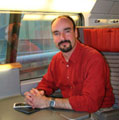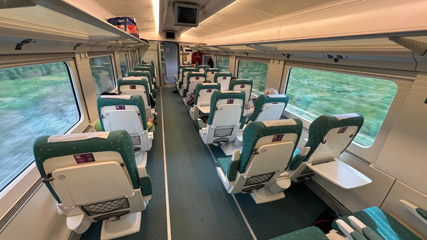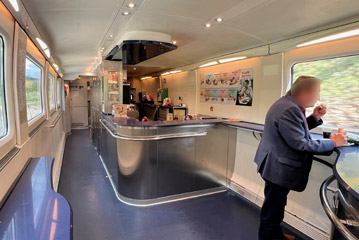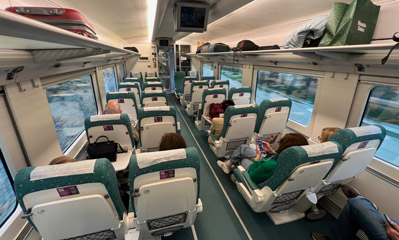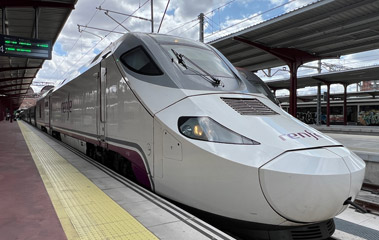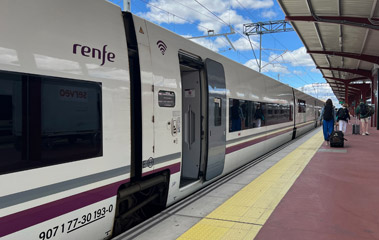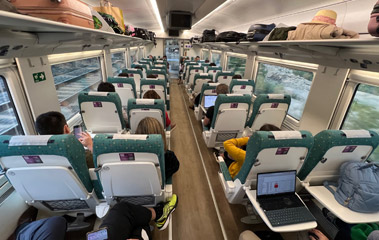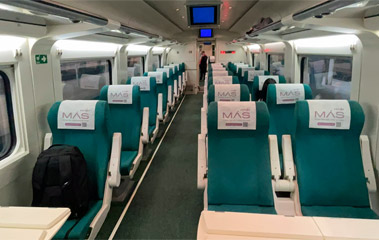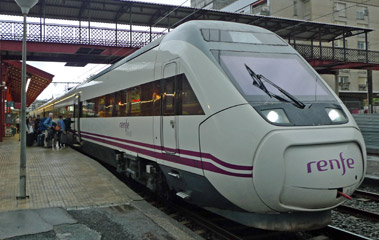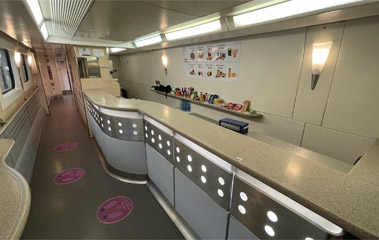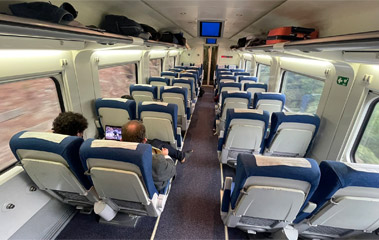Renfe's gauge-changing high-speed trains
Alvia is Renfe's brand name for their second-rank high-speed trains after AVE. Alvia trains come in 3 types:
![]() S130 trains are used on Alvia services from Madrid to
Cadiz, Huelva, Gijon & Santander.
S130 trains are used on Alvia services from Madrid to
Cadiz, Huelva, Gijon & Santander.
![]() S730 trains
are used on Alvia services from Madrid to Ourense, Vigo, Santiago de Compostela
& A Coruña.
S730 trains
are used on Alvia services from Madrid to Ourense, Vigo, Santiago de Compostela
& A Coruña.
![]() S120 trains are used on Alvia services from Madrid &
Barcelona to Bilbao, Pamplona & San Sebastian.
S120 trains are used on Alvia services from Madrid &
Barcelona to Bilbao, Pamplona & San Sebastian.
Alvia S130
These trains have standard & comfort class and cafe-bar, with power sockets at all seats but no WiFi. Built by the Talgo company and capable of 250 km/h (155 mph) on high-speed lines, they consist of little articulated coaches sandwiched between two duck-billed power cars - it's no surprise that Renfe staff call them Patito or little duck. Their unique Talgo design involves just one pair of wheels under each articulation, and they can change track gauge from standard gauge (4' 8½") used for most Spanish high-speed lines to Iberian gauge (5' 6") used on the classic Spanish network. When your train passes through a shed at 20 km/h during its journey, its changing gauge!
S130 Alvia train at Santander.
Comfort (1st) class seats on an Alvia train. Above right, a menu Iberico meal deal from the cafe-bar.
The cafe-bar and standard (2nd) class seats on an Alvia train.
Alvia S730
Standard & comfort class and cafe-bar, with power sockets at all seats but no WiFi. These trains are Identical to the S130, but with a diesel power car at each end in addition to the regular electric power car, so they can reach the non-electrified extremities of the network.
Above left, comfort (1st) class seats on an Alvia S730 train, recently refurbished in tan leather. The cafe-bar is identical to the S130.
Above left, boarding at Madrid Chamartin. Above right, standard (2nd) class seats on an Alvia S730 from Madrid to Vigo.
Alvia S120
Built by CAF and capable of 250 km/h (155 mph) on high-speed lines, these trains operate between Madrid/Barcelona and Bilbao/San Sebastian and some other routes. They have standard & comfort class and a cafe-bar, but no WiFi. Some S120s have power sockets at seats, but many don't so make sure your phone is charged or take a powerbank. Like the S130s, their axles can change track gauge from standard gauge (4' 8½") used for most Spanish high-speed lines to Iberian gauge (5' 6") used on the classic Spanish network. When your train passes through a shed at 20 km/h during its journey, its changing gauge!
Travel tips
-
Should you go Standard or Comfort class?
Standard class is absolutely fine for most travellers. Seats are arranged 2+2 across the car width. Comfort class gives you more leg & elbow room with seats arranged 2+1 across the car width.
-
Seat maps
For seat numbering plans, see the seat maps page.
You can choose your seat from a seat map if you book at www.thetrainline.com (easy to use, in €, £ or $, small booking fee) or www.renfe.com (more fiddly, in €), but not (at the time I write this) at any other retailer.
-
Luggage
Like any European train, you take your luggage in with you and stick it on any suitable rack near your seat. The overhead racks will take anything up to backpack or medium suitcase size, floor-standing racks at the car ends will take larger suitcases. There is a theoretical limit of 3 items and 25 Kg, but nobody weighs it or measures it, so no worries.
-
X-ray luggage control
You have to put your luggage through an X-ray scanner before boarding a Spanish high-speed train at a station on the high-speed network. But not when boarding a train at a station on the classic network.
In other words, you'll have to go through luggage control when boarding an Alvia train in Madrid, Barcelona or Vigo Urzaiz, but not when boarding at Vigo Guixar, Santander and so on, although there's usually a ticket check before you're allowed onto the platform. Go figure...
Luggage control only takes a few minutes, there are no metal detectors so it's nothing like an airport. Security staff next to each scanner may have a metal-detecting 'wand' but on a recent trip the 'wand' was used on me once in 8 trips and even then they failed to find the corkscrew in my left pocket or iPhone in my right one, it's basically security theatre. Your ticket is usually checked before boarding, too. Tip: Put any Swiss Army knives or corkscrews in your pocket to avoid arguments if they see them in the scanner. Boarding an Alvia at Madrid Chamartin. Boarding an Alvia at Madrid Atocha. Boarding an Alvia at Barcelona Sants.
-
Seat reservation
Alvia tickets come with a reserved seat automatically included.
-
Infants need a ticket
Infants under 4 travel for free if they don't need their own seat. However, unlike almost all other European countries, you can't just bring them along without a ticket. On Spanish high-speed trains they need a zero-fare ticket showing their name. You'll get this if you enter them as a passenger with their actual age when you buy tickets at www.thetrainline.com, www.raileurope.com or www.renfe.com.
-
Food & drink
The cafe-bar car serves snacks, hot dishes, coffee. soft drinks, beer & wine. You are of course free to bring your own food and drink along to eat & drink in your seat, even a beer or bottle of wine if you like.
-
WiFi & power outlets
There's no WiFi on Alvia trains, but mobile data will usually work fine most of the way.
On S130, S730 and some S120 there are power outlets at all seats of the usual European 2-pin type. Some S120s are not fitted with power sockets, so make sure your phone is charged or carry a powerbank!
-
Interrail & Eurail passes
You can uses passes on Alvia trains, reservation required for a fee, see the reservations page.
-
How to check which train type operates your Alvia
Unlike AVEs where different types may operate different departures on the same route, you can be pretty sure that any Alvia to Santander is an S130, any Alvia to Vigo, Santiago de Compostela or A Coruña is an S730, and any Alvia to Bilbao or San Sebastian is an S120.
However, the only way to be sure is to make a dummy booking at www.renfe.com, selecting an Elige fare, inputting all necessary dummy passenger data, adding seat selection, then at the final seat selection stage it shows a seat map and side view of the train type, allowing me to identify the type of Alvia used on that train.
